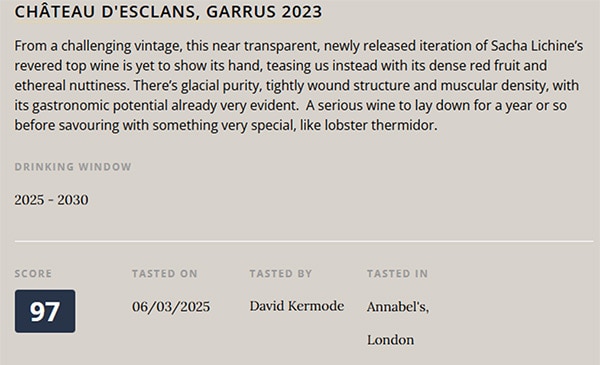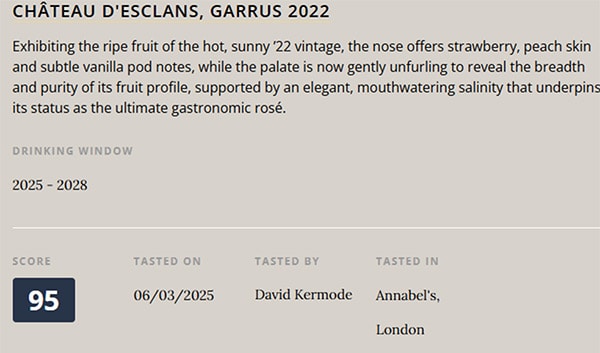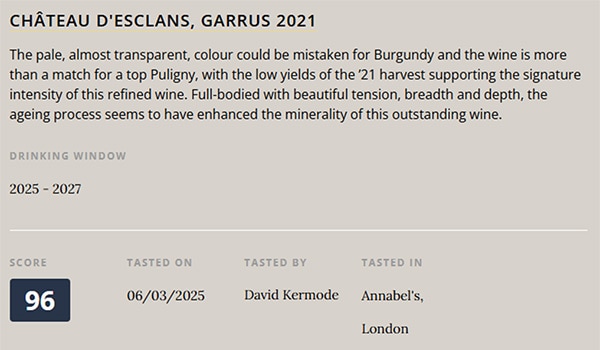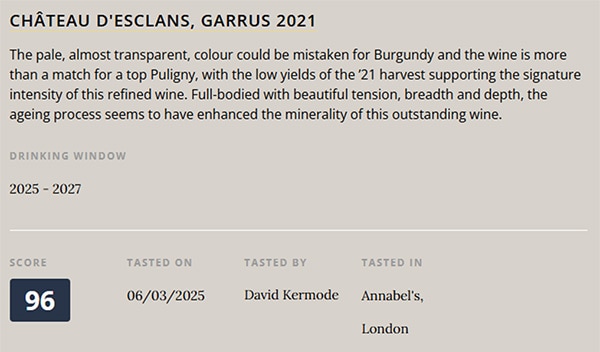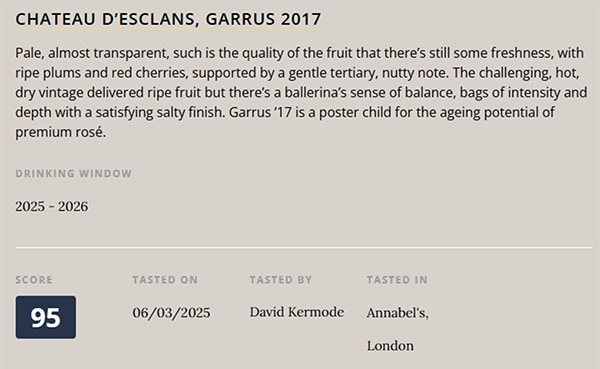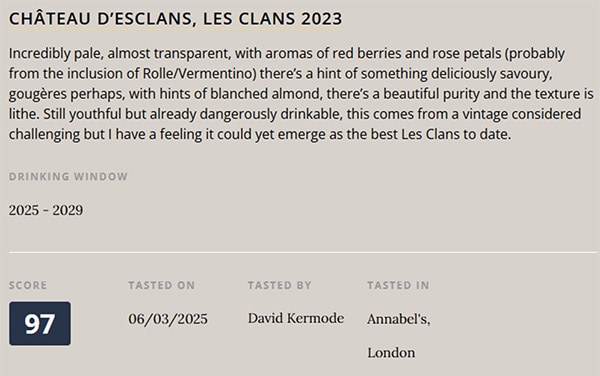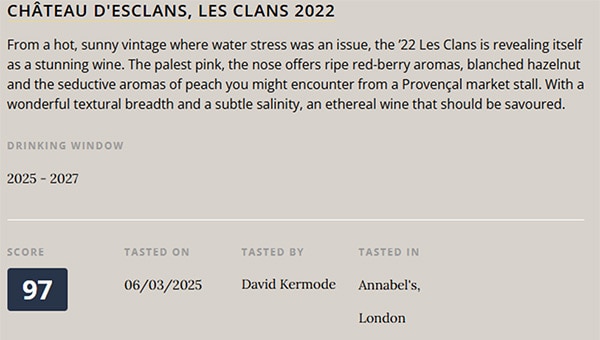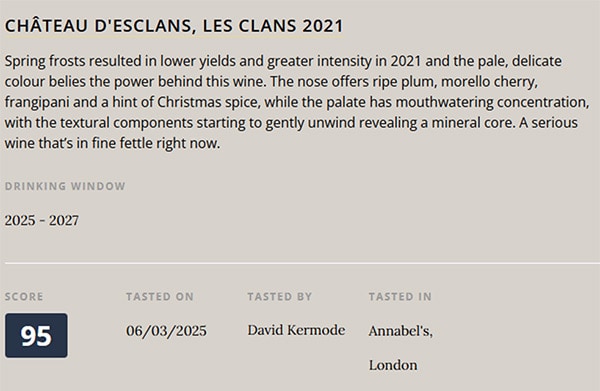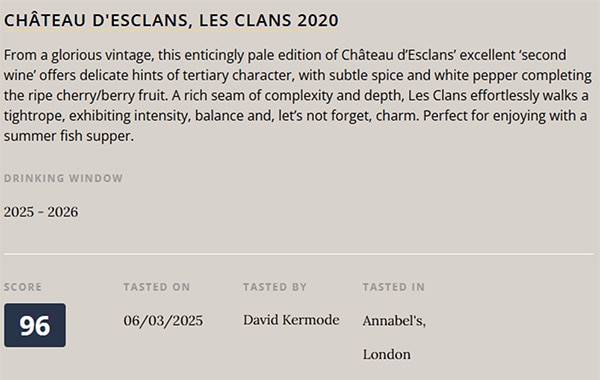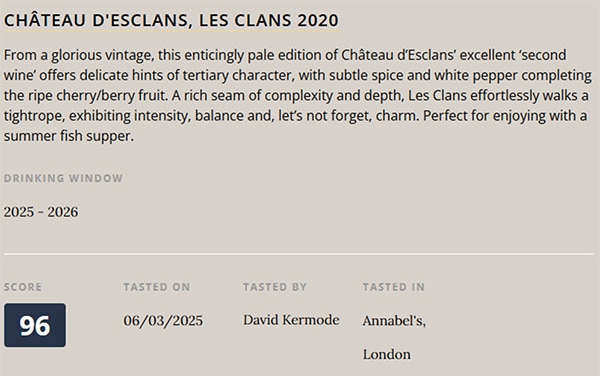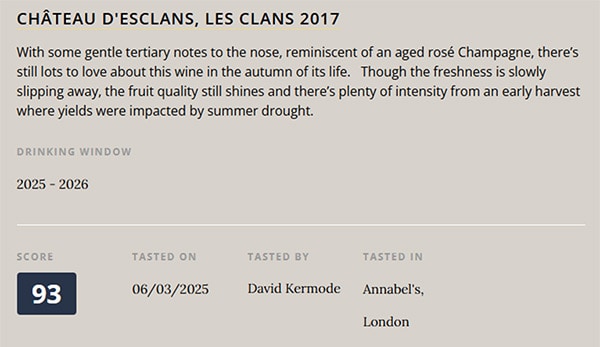Critical Acclaim: A Vertical Tasting of Les Clans and Garrus Vintages in London
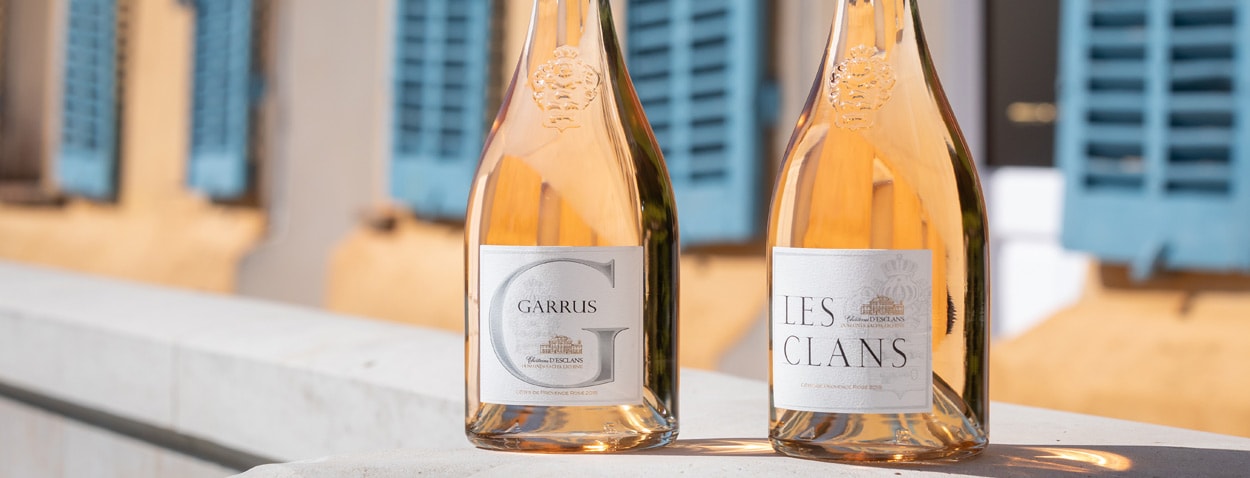

Sacha Lichine on premium rosé: ‘We’re not trying to change the world. We’re trying to get the word out’
12th March 2025
By Sophie Arundel
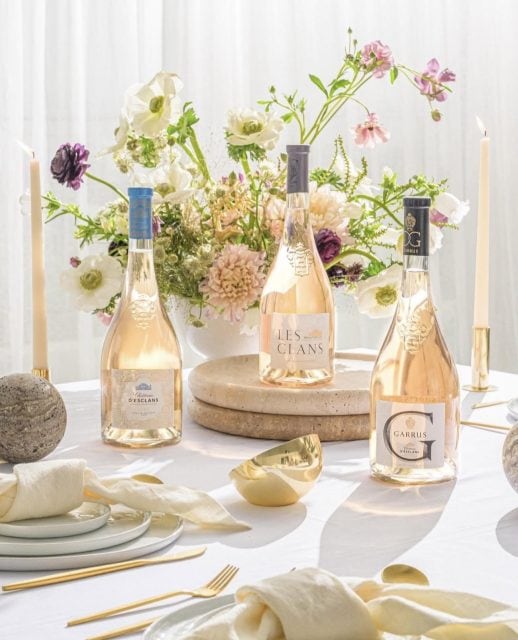
Rosé has long been the drink of choice for sunseekers in St Tropez and après-ski party-goers in Courchevel. But while it’s still synonymous with beach clubs and bottles on ice, Château d’Esclans isn’t on a mission to rewrite the script—just to offer premium rosé as an option for those who want it.
If you think rosé, you might think of magnums being poured from height into peoples mouths at La Folie Douce, or endless glasses poured along the Riviera by those wanting a quick route to tipsiness under the Mediterranean sun. It’s not exactly a category steeped in the reverence afforded to Burgundy or Bordeaux. But one producer that has undeniably reshaped perceptions is Château d’Esclans—the house behind Whispering Angel. Whether you love it or not, there’s no denying its cultural impact.
On Friday 7 March, an intimate lunch at Annabel’s in Mayfair (because where else?) set the stage for a deeper dive into Château d’Esclans’ premium rosé offering. The table, filled with pastel-hued flowers mirroring the soft pink hues of the Garrus 2024 and Les Clans 2024 vintages, framed a discussion around where rosé fits in the fine wine world.
A different approach to premium Rosé
At the lunch, Lichine was clear about his intentions: “We’re not trying to change the world. We’re trying to get the word out.” Rather than waging a campaign to convince sceptics that rosé is a “serious” wine, the goal is simply to offer premium rosé in a premium setting. Fine dining restaurants, Michelin-starred establishments, and collectors’ cellars—places where traditionally only white and red have had a seat at the table.
The UK has driven fine wine trends for centuries. As Lichine noted, “If it wasn’t for the UK, there wouldn’t be a fine wine market.” Whether UK drinkers will embrace premium rosé in the same way remains to be seen. But with bottles of Garrus and Les Clans appearing in more high-end settings, it’s clear that Château d’Esclans has already succeeded in making it an option.
The wines: Beyond the beach club
Esteemed wine author Jane Anson has described Les Clans as a “serious wine that still has the fresh lightness of touch of a perfect summer rosé,” and the tasting notes back that up.
Garrus is often likened to an elegant white Burgundy. Made primarily from nearly century-old, low-yielding Grenache vines, it is the most complex expression of Côtes de Provence rosé. Comprising 90% free-run juice, the wine is vinified in 600-litre temperature-controlled oak barrels, undergoing bâtonnage twice weekly over an eleven-month period to build structure and depth.
Les Clans, the sibling to Garrus, offers a more structured take on rosé, balancing its fresh, summer-ready minerality with a rich, satiny texture. Made from old-vine Grenache and Rolle, it undergoes ten months of ageing in new and second-year demi-muids, developing woody, vanilla, and fresh fruit notes alongside a saline finish.
With over 10 million bottles of Whispering Angel sold annually, the brand has undoubtedly dominated the rosé space. But while the name has become ubiquitous, Château d’Esclans’ top cuvées are designed to show that rosé doesn’t have to be an afterthought on a fine dining wine list.
Innovation in winemaking
Château d’Esclans has pioneered technological advancements in rosé production. As Sacha Lichine himself put it, “You wouldn’t be able to make rosé like this if it wasn’t for the technology.”
Rosé is deceptively difficult to produce well, particularly when the goal is to achieve a Burgundian level of complexity while working with diverse terroirs. The process begins with carefully picked and sorted grapes, which are cooled and pressed before entering a sophisticated temperature-control system. Here, a double-layered stainless steel heat exchange system rapidly drops the temperature from around 25°C to 7-8°C, preserving freshness and aromatic intensity.
The next step, a closed-loop press system using inert nitrogen gas, prevents oxidation while enhancing the wine’s clarity and purity. The resulting free-run juice undergoes degumming, allowing unwanted solids to settle before fermentation. The end result? A clean, precise rosé with a pale, elegant hue and a depth that challenges preconceptions.

Wednesday Wines – Episode 255 – Ageless Esclans & 2024 Whispering Angel
12th March 2025
It was a joy to reenact a Château d’Esclans vertical tasting last week with its founder Sacha Lichine, some eight years after I hosted the same event in New York City with the late Château d’Esclans winemaker Patrick Léon. These stellar rosés have an uncanny ability to age. They do so, not in a linear fashion like, say, a predictable red wine, but in a swirling, convoluted and always surprising manner. After tasting the newly released 2023s, which I reviewed in my Finest Fifty 2024 Report published back in January for members of matthewjukes.com, we dived into some older vintages of Les Clans and Garrus. I have no images of this event as there are strict rules at Annabel’s private club regarding photography, so I have included a photo taken back in November when I first tasted these wines, as well as a bottle shot of the new 2024 Whispering Angel, whose review also features below.
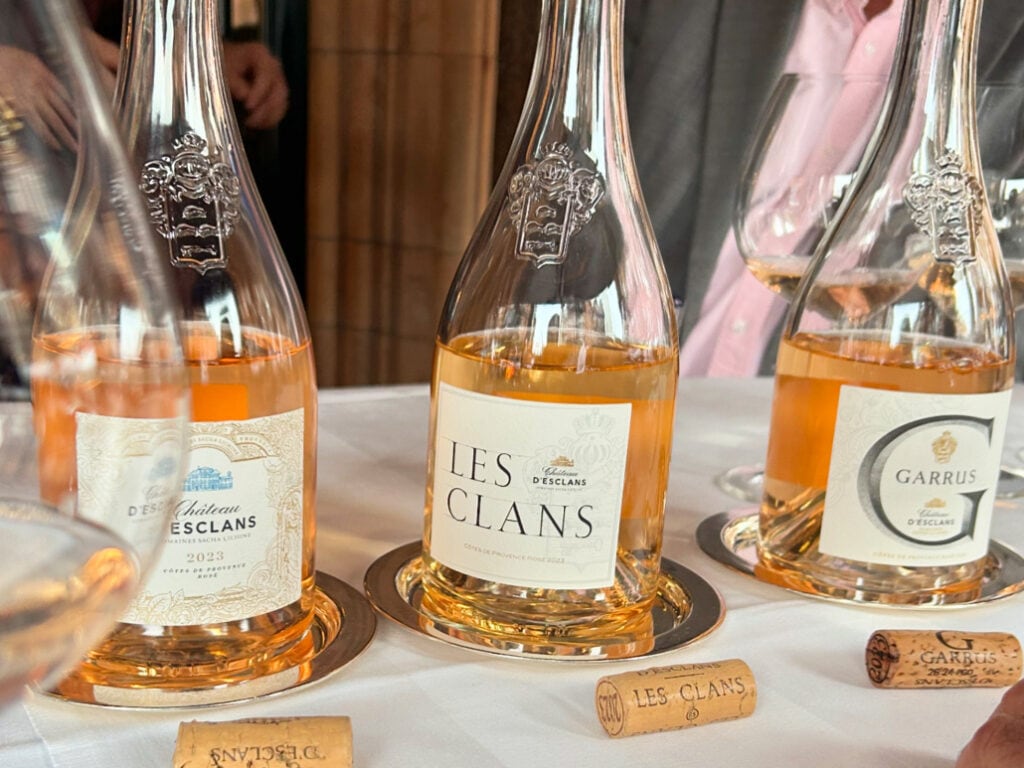
2023 Château d’Esclans Les Clans Rosé, Côtes de Provence, France
2023 will go down in Provence rosé history as the vintage when all three ‘Château d’Esclans’ wines hit the high notes simultaneously. The trio of 2023s have only just been released, and I was privileged to taste them with Sacha Lichine in London in November. This tasting further underlined that these are genuinely authentic fine wines that stand shoulder to shoulder with the world’s top sparklers, whites and reds. Garrus has long been the grandest rosé on the planet, and I find so much to admire in this wine; it is incredible. 2023 Château d’Esclans Garrus Rosé is firm, bright, crystalline and refined with blonde oak and blanched almond highlights. This level of composure is usually only found in graceful Grand Cru Burgundies. Precision cut, reserved and reluctant to show its full hand this early in its development, this is another cosmic performance from this trailblazing wine. My headliner, Les Clans, shows another level of elegance, coupled with lip-smacking precocity, so while Garrus is one for the cellar, Les Clans is ready to romance from the moment it is released. Near perfect in weight, timbre and balance, this is a glorious wine, and it can perform every duty from complex canapés to main course feasts! Where Garrus slows the conversation down so one can fully appreciate the constellation of flavours present, Les Clans skips along merrily, making it the definitive ‘rich person’s fast wine’. If you were left to your own devices, I could see Les Clans disappearing at an impressive rate of knots without ever tiring the taste buds or becoming repetitive. Finally, it is extremely exciting to announce that the estate wine, 2023 Château d’Esclans Rosé, has finally – and it has been a bit of a wait – joined its fellows at the top of the tree. For as long as I can remember, this cuvée has been meandering around, searching for a purpose. Whispering Angel and Rock Angel have bookended this portfolio at the commercial end, and Les Clans and Garrus soared around the stratosphere, leaving ‘Château’ somewhat lost. In 2023, there is so much gravitas and purity that it has gone from also-ran to catwalk-ready in one fell swoop. I would go so far as to say the silhouette of this wine is more Puligny-like than many Pulignys! This is easily the most exciting estate Esclans to date, and it is fabulously open and vibrant with skipping-stone flavours and lashings of joie de vivre. What a trio! 19/20 (Drink now – 2028)
Adding to this tasting note –
2023 Château d’Esclans Rosé looked even more composed and refined than in November, and it was a consummate aperitif wine with stunningly decadent canapés. We tasted through Les Clans 2023, 2022, 2021, 2020 and 2017. The 2023 is clearly a thoroughbred; despite its youth, it looked every inch a superstar, as noted above. The 2022 was spicier and more crunch and active on the palate, and I loved the brittle acidity on the finish. 2021 was more expressive, fleshy, and main course shaped. It was just starting to hit its peak! The 2020 was a wickedly delicious wine with stunning balance and completeness. I have always adored this vintage. The 2017 was tiring a touch, but it shows that at eight years old, there is still energy in the tank. Remarkable. We then repeated the same vintages with Garrus and as you might expect, the flavours were bolder, fuller and more dashing! The 2023 is a masterful creation, but it is tense and coiled! The 2022 looked ravishing. I have always had a soft spot for this awesome wine, and it is just starting to show signs of softening. That said, it is possible to bathe in its glory already, as long as you have the right food in front of you (we enjoyed roast chicken). 2021 showed more crystalline traits with lashing so juicy fruit, straight-jacketed by thrilling acidity. Drinking, but with so much class and tension, this will run and run. The 2020 was typically silky and beautiful – an haute couture vintage – and it is drinking well now and will continue for a good few years to come. The 2017 is an event horizon wine! It was a challenging vintage and a triumphant result. Drinking beautifully, with incredible grace and kaleidoscopic complexity, it underlines that this collection of rosé wines is the most age-worthy and delicious in the wine world, and they deserve a place in the very finest cellars on earth.
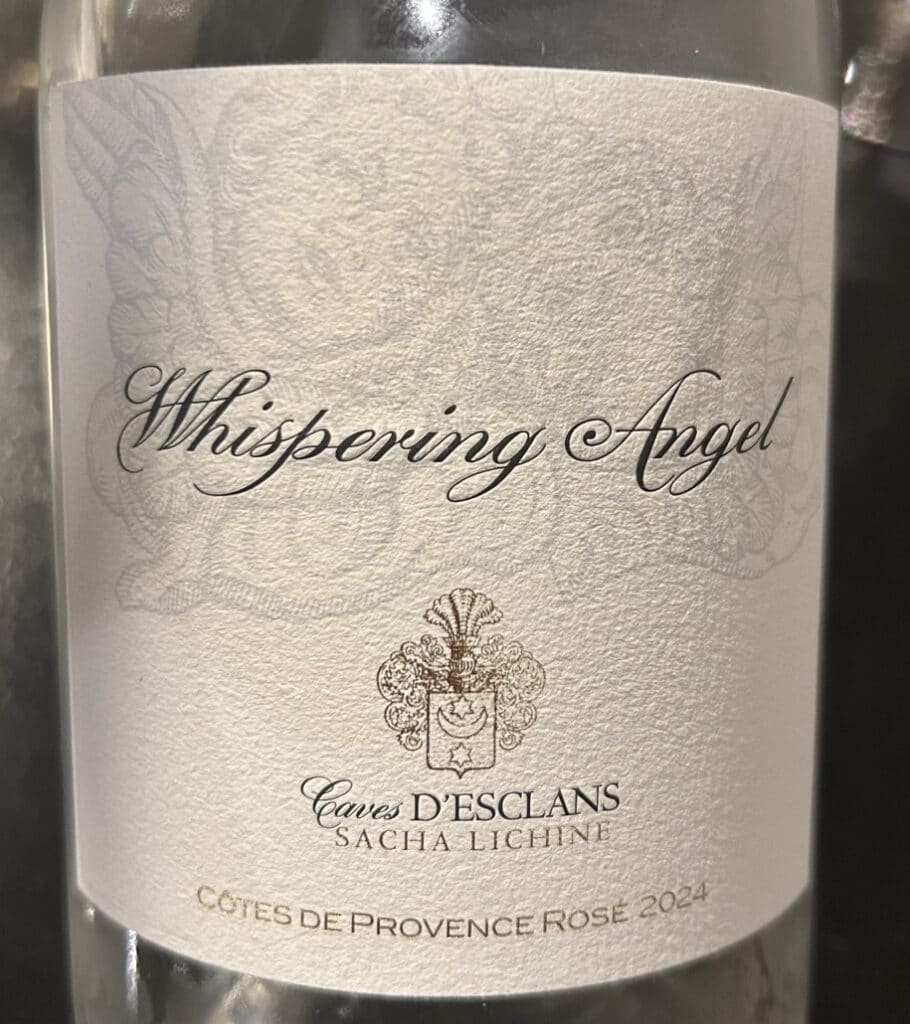
2024 Whispering Angel Rosé, Caves d’Esclans, Sacha Lichine, Côtes de Provence, France
As I talked with Sacha, he let me into a secret. He thinks 2024 is one of the finest vintages he has ever seen in Provence. And, if this wine is anything to go by, he is right. This is a seamless, languid, soothing Whispering Angel with terrific balance and immediate appeal. Sometimes, this wine takes a couple of months to get into its stride. Sometimes, it misses summer altogether, falling into equilibrium in time for turkey at Christmas, although I suspect no one notices or even cares! In 2024, it is impeccable from the off. This is justifiably the most famous / best value rosé in the world and if anyone still thinks otherwise, one sip of this beguilingly lip-smacking wine will change their minds – Chapeau!
There are many suppliers of all these wines in the UK, including countless retailers for Whispering Angel, so you are likely to find it everywhere given that 10m bottles are produced, but the Estate wines can be found from Vinatis, Selfridges, Fine Wine Direct, Hedonism Wines, Vinvm, ND John, Millesima, Jeroboams and Harrods.
After some frenzied surfing, the merchant with the widest collection and the keenest prices appears to be

Château d’Esclans: Would you pay for rosé that tastes like Burgundy?
By Joanna Simon
Joanna Simon tastes five vintages of two of the world’s most expensive rosés, Garrus and Les Clans, siblings of Whispering Angel, and asks the question: is it worth it?
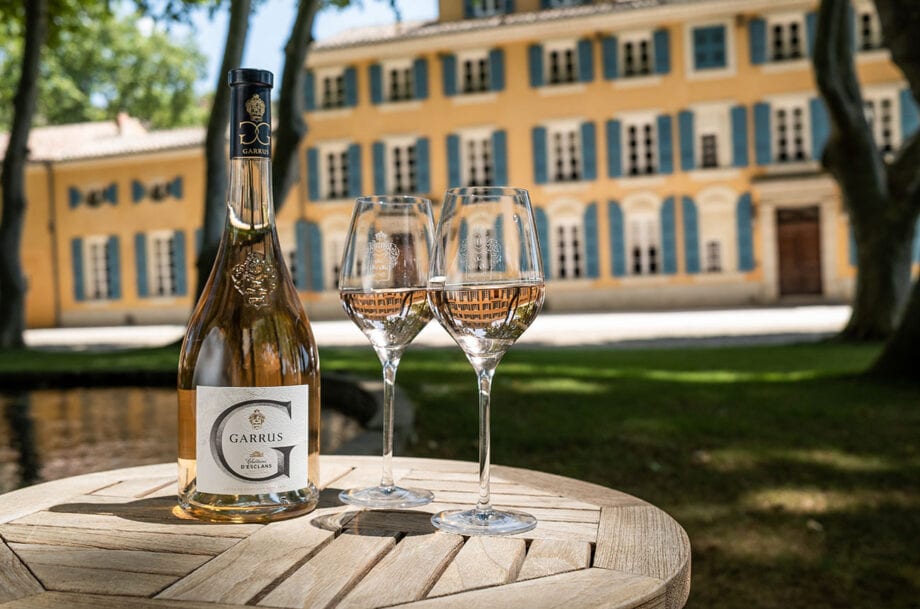
In the early 2000s, the French were drinking more white wine than rosé.
By 2008, however, mainstream media were reporting that sales of rosé had overtaken those of white for the first time. Since then rosé has swept the wine world.
The production and consumption of rosé has been increasing worldwide.
And styles are inevitably changing. Rosé is serious business and a serious wine. There are now rosés that can be cellared and aged.
Sea change
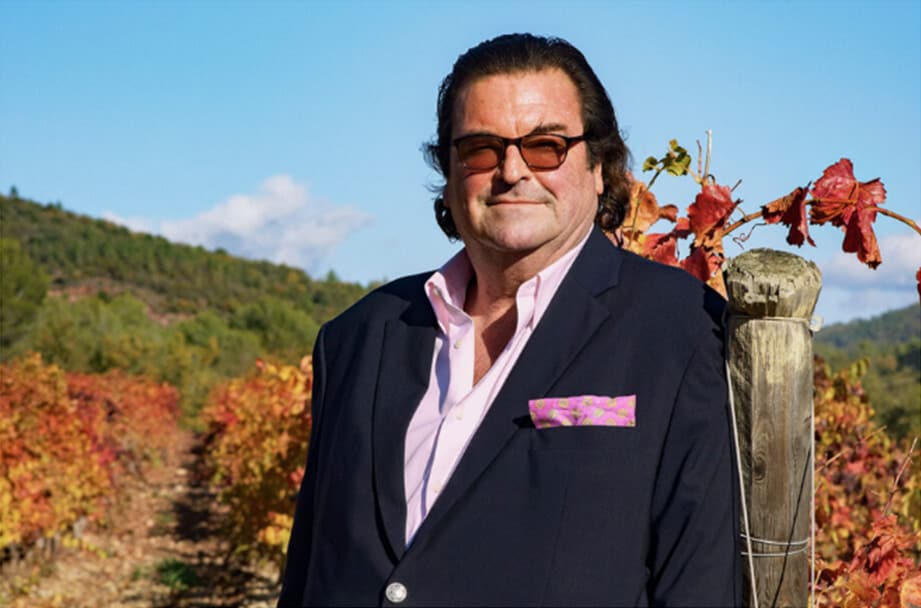
If there’s one man who can take the credit for this sea change, it’s Sacha Lichine.
In 2006, he created Whispering Angel, a Côtes de provence rosé that he describes today as ‘closer to a spirits brand.’ as well as two oak-fermented rosés. Garrus and Les Clans, from his estate Château d’Esclans.
While he originally went on the property reecce in search of the sun, his vision became to create the world’s most expensive rosé, a wine of elegance and precision, complexity and ageability, that could hold its own among other fine wines – whites, reds and not least Burgundy.
The estate’s vineyards are in the limestone-rich soils of the upper Esclans valley in the Var department, wich he leased and then finally bought in 2005 after selling Château Prieuré-Lichine, in Margaux, in 1999.
Developing the style of a fine rosé
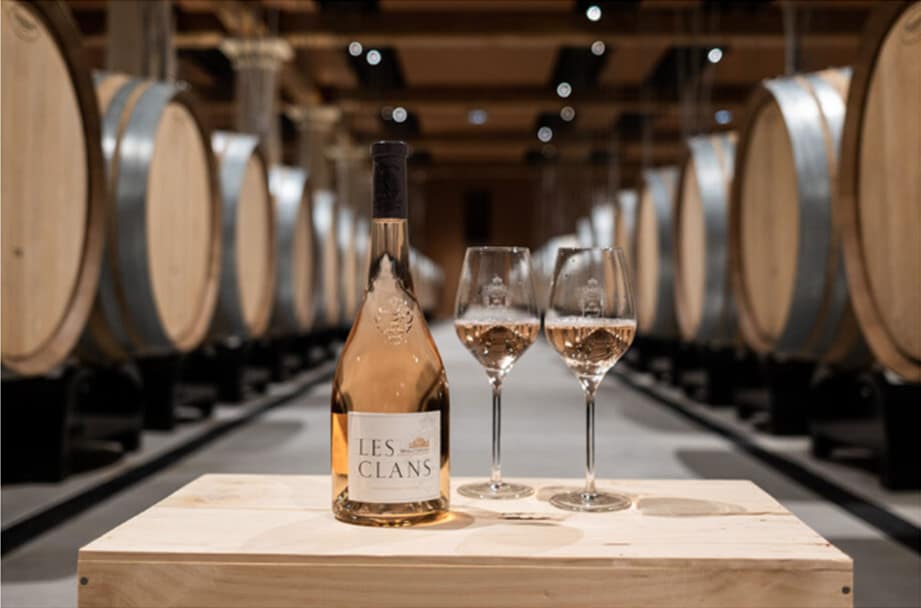
The technical director Lichine recruited to realise this vision was a Bordeaux winemaker, Patrick Léon, recently retired from Château Mouton Rothschild.
But the inspiration for the winemaking of Garrus and Les Clans was white Burgundy:fermentation and ageing in new oak with twice weekly batonnage.
There has been fine tuning over the years. Both fermentation and maturation are now in 600-litre demi-muids, instead of 500-litre barrels, and each is individually temperature controlled.
The wines are aged for 10 months and the oak is a mix of new, second and third use. Most of the barrels are from coopers Seguin Moreau, critically, they’re only very lightly toasted.
Other fundamentals include picking in the cool early morning, a three-stage grape sorting process, cooling the grapes down to 7°C-8°C, and a closed-circuit ultra-light pressing process that results in very pale, basically free-run juice (85%-90% in the case of Les Clans).
The average vine age is 50-70 years for Les Clans and ‘a little bit older’ for Garrus, according to Lichine.
Where they diverge radically from Burgundy is of course in their grape varieties: 78%-80% Grenache ‘for elegance’, says Lichine, and 18%-20% Rolle ‘for richness’.
There is a smidgen of Syrah and there could be a tad of Tibouren and Cinsault.
Making wine that sells
‘Everyone bought I was off my head to sell a fourth-growth Bordeaux to do this,’ says Lichine.
What they didn’t appreciate is that Sacha Lichine not only knows how to make wine and run an estate, he knows how to sell wine.
It may be the less romantic side of the wine business (although it can be glamorous at the upper echelons), but it was key to Esclans’ success and the subsequent global rise of rosé.
Has Lichine achieved what he set out to do? In my view, yes. The wines are rich and vinous yet elegan, and they become more complex with age.
Garrus, especially, starts out more like Burgundy, and become more like red Burgundy with age, wich surely can’t be bad.
Are they worth the money? Only you can decide what to spend your money on, but their quality compares with wines of equivalent price.
Notes and scores for five vintages of Garrus and Les Clans
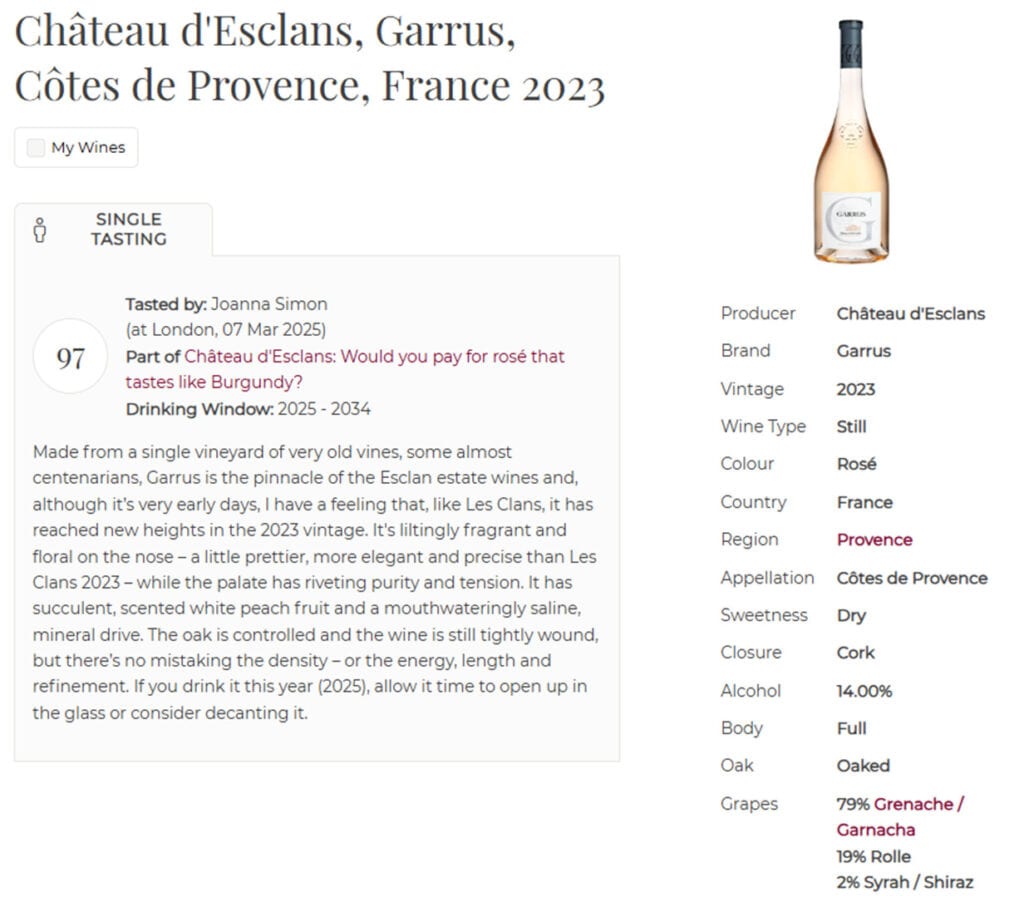
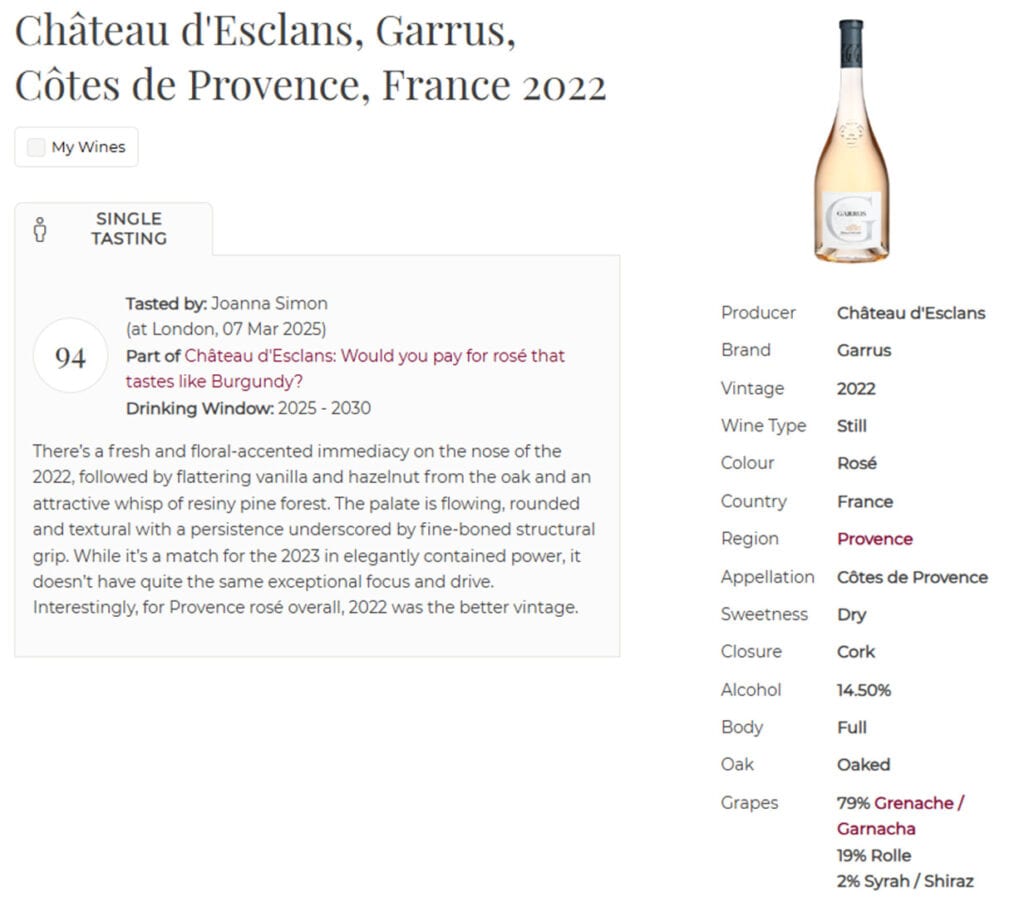
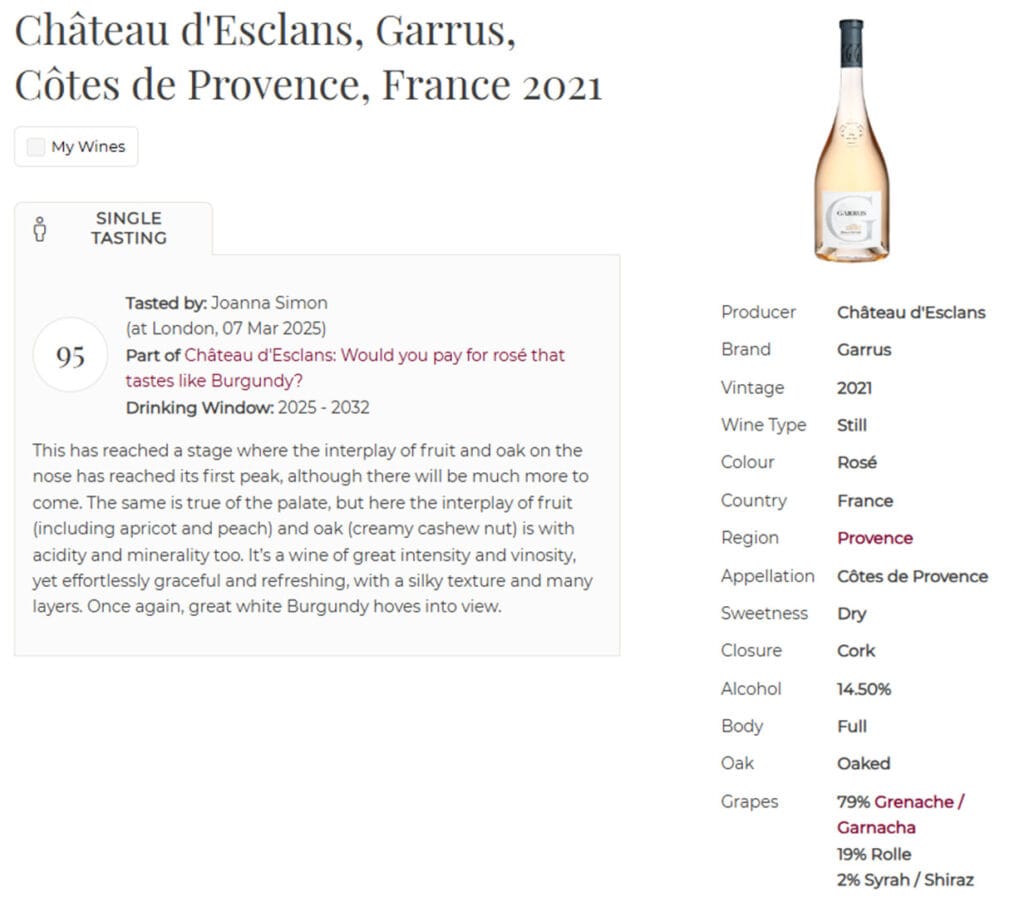
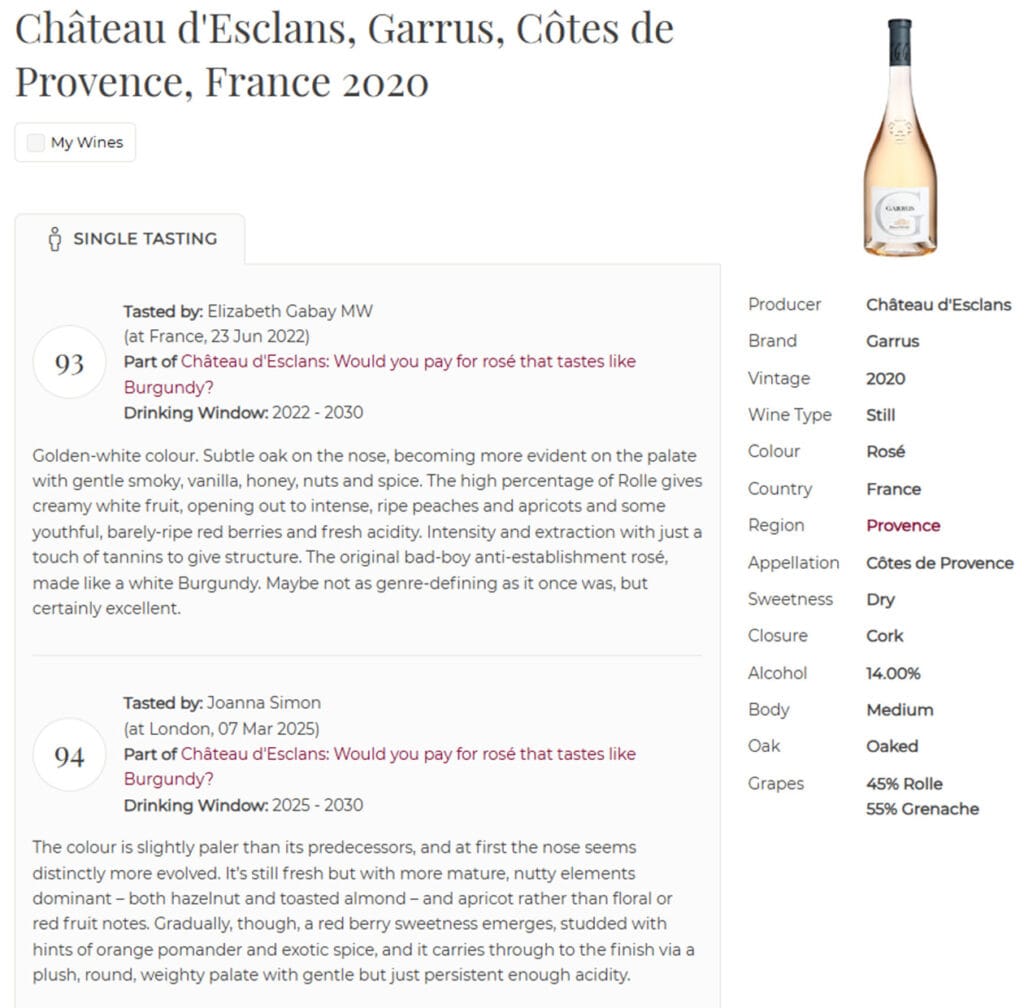
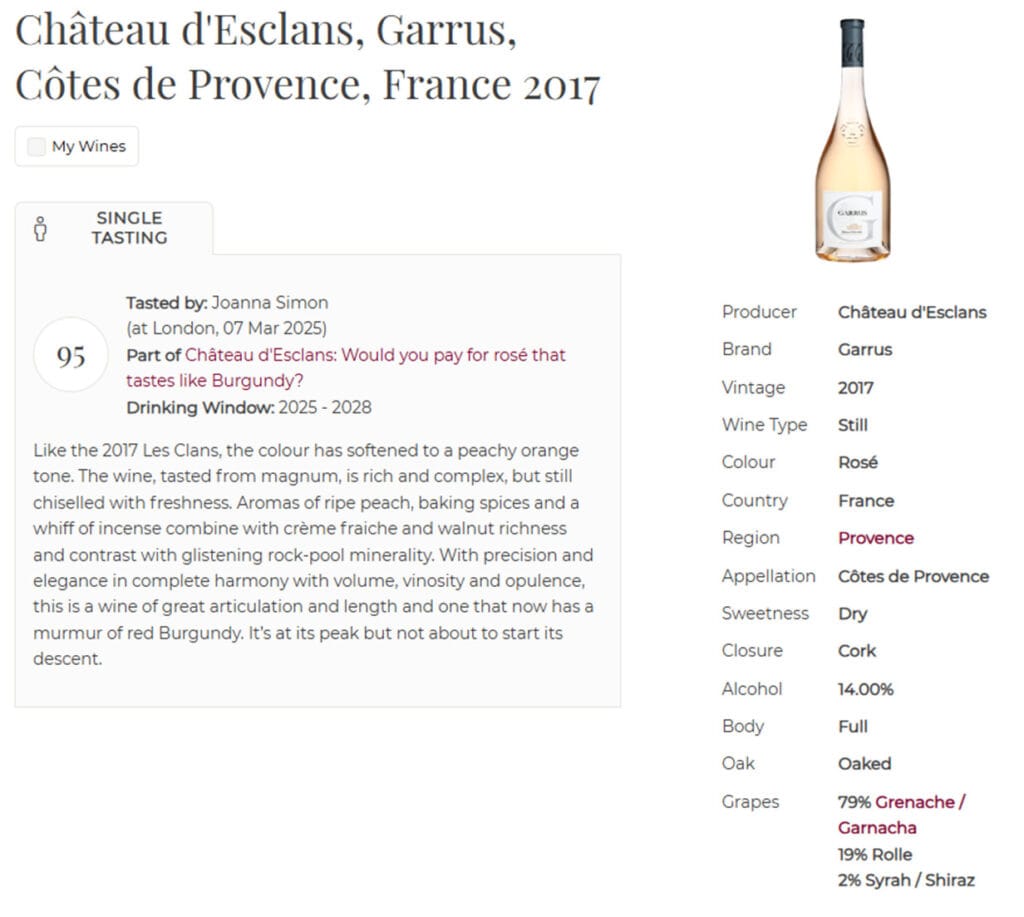
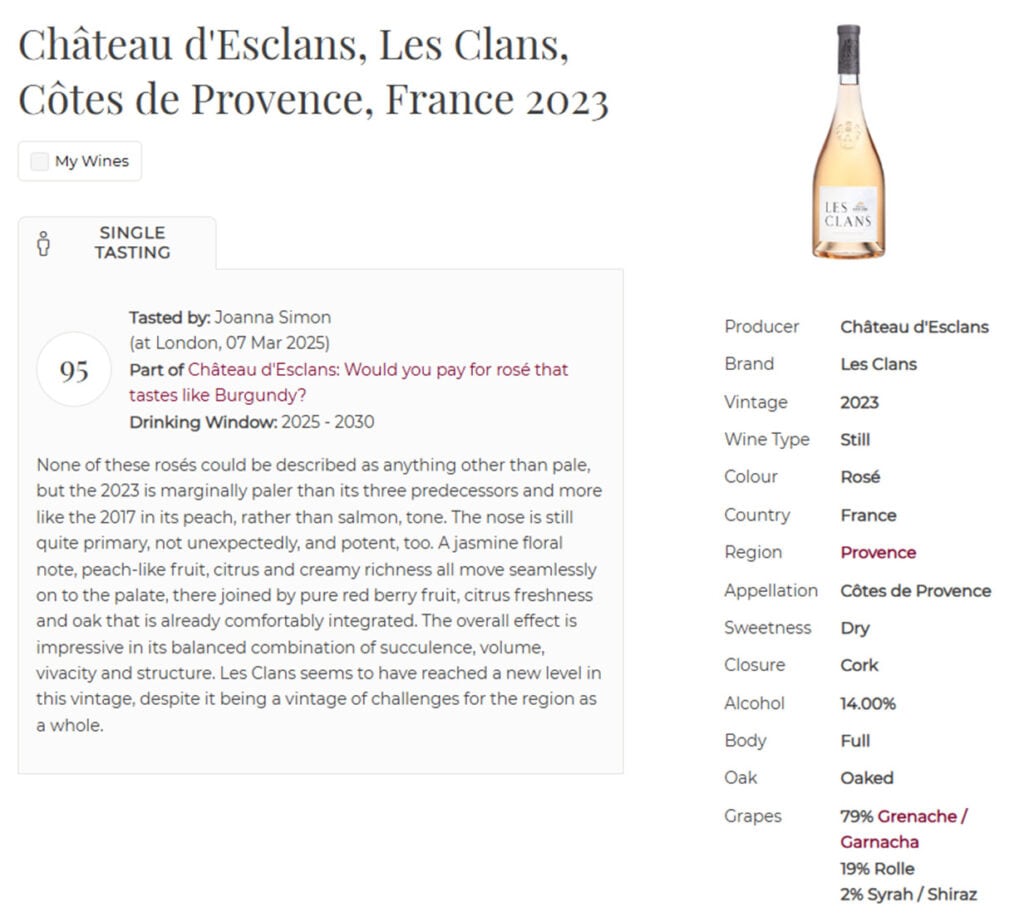
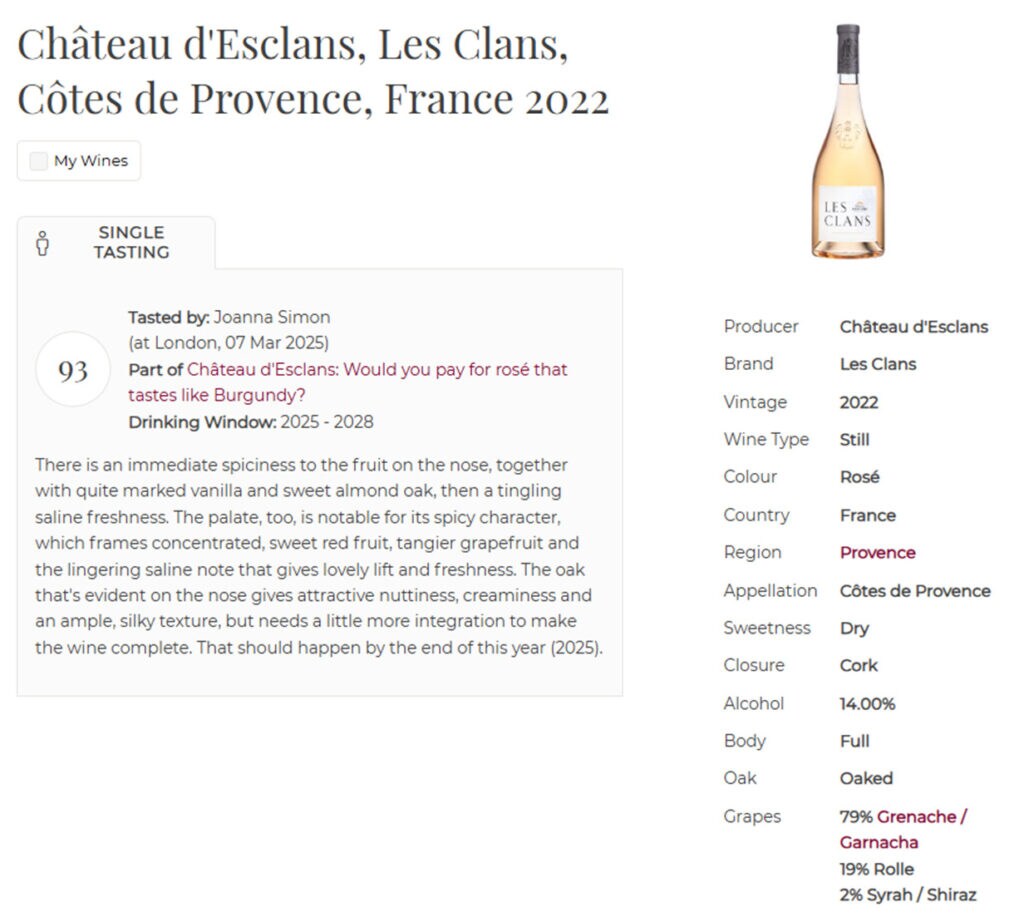
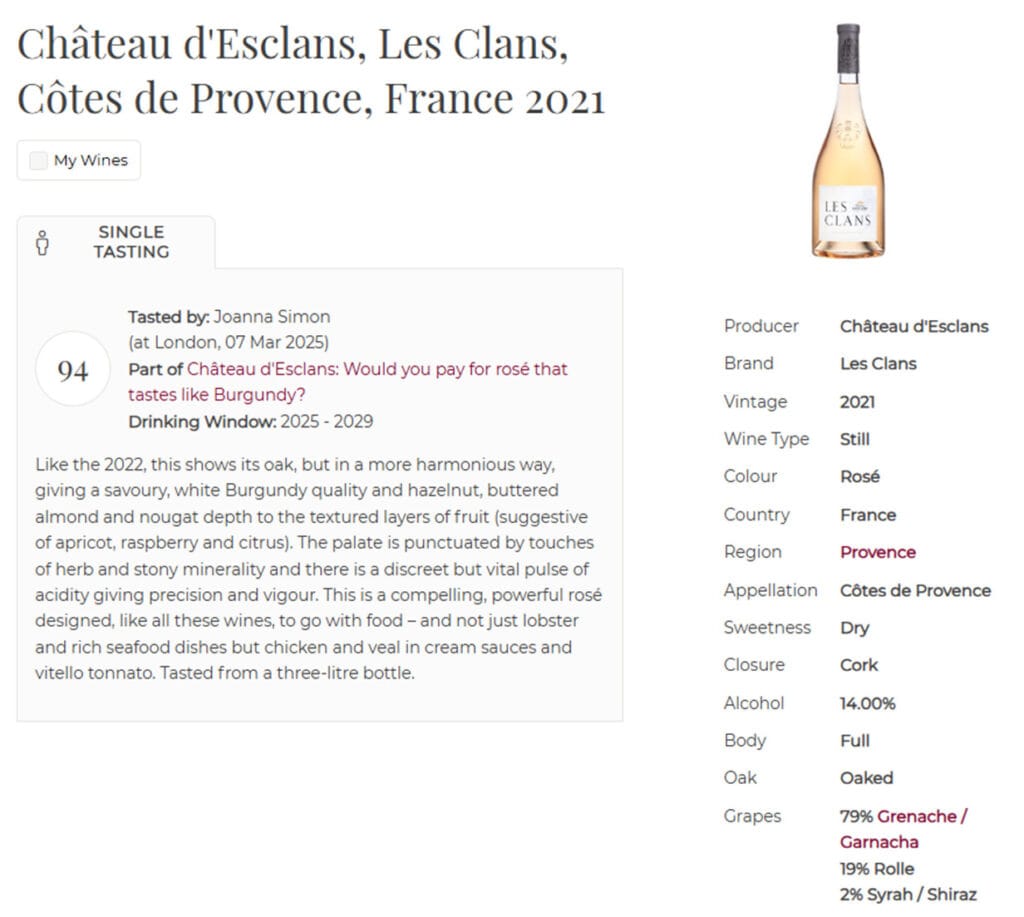
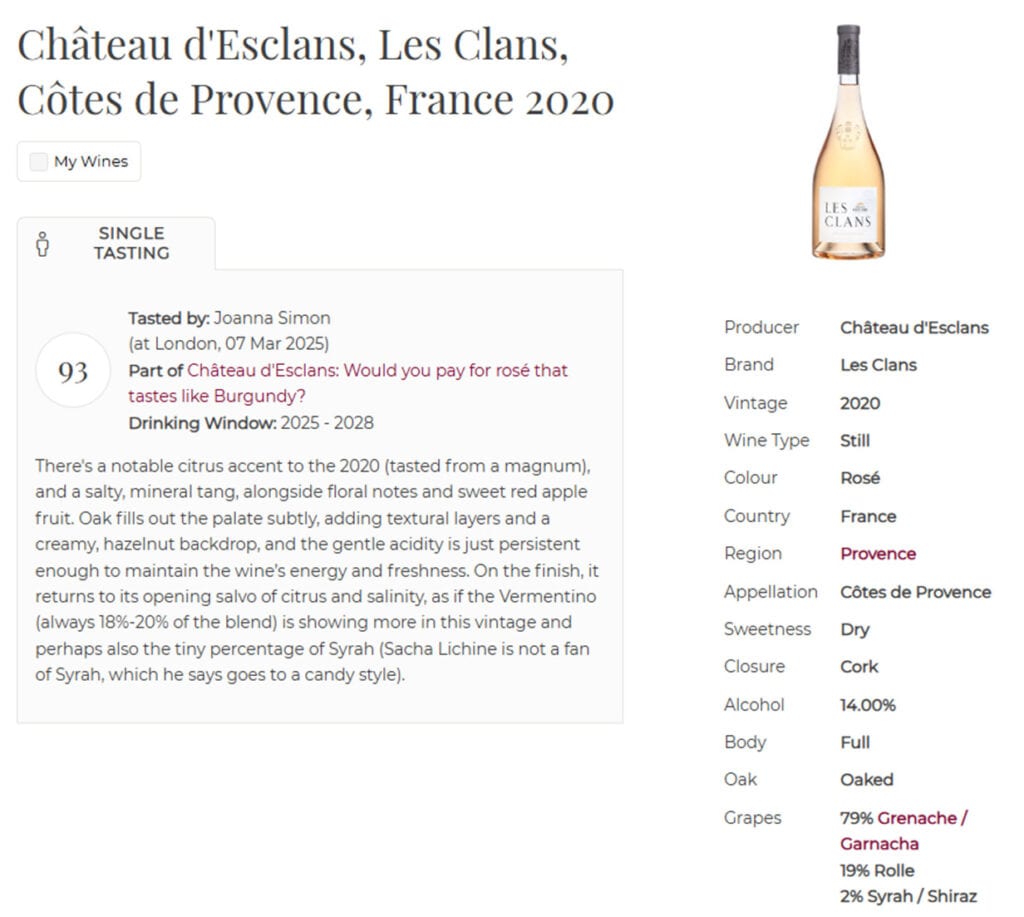
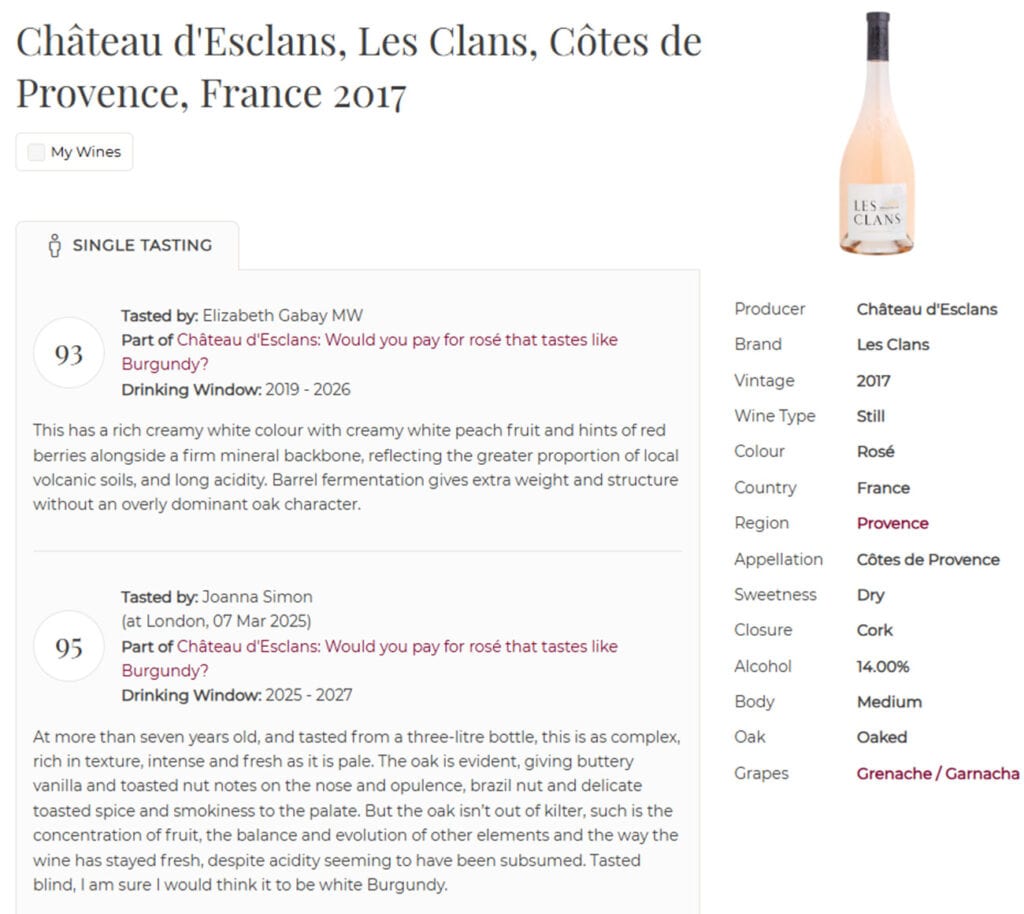

NO RISK NO FUN – SACHA LICHINE ON FINE ROSÉ WINES
17th March 2025
By Darren McCabe Food & Drink
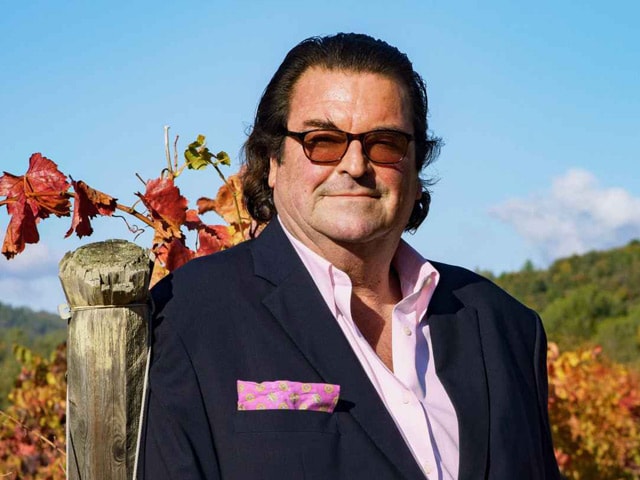
Chateau D’Esclans Les Clans & GARRUS Vertical Tasting
On Friday, March 7th, I had the pleasure of joining Sacha Lichine, the visionary founder of Château d’Esclans, for a delightful lunch at Annabel’s in Mayfair. The highlight of the afternoon was a vertical tasting of the exquisite Les Clans and Garrus fine wines, held in the elegant surroundings of Annabel’s.
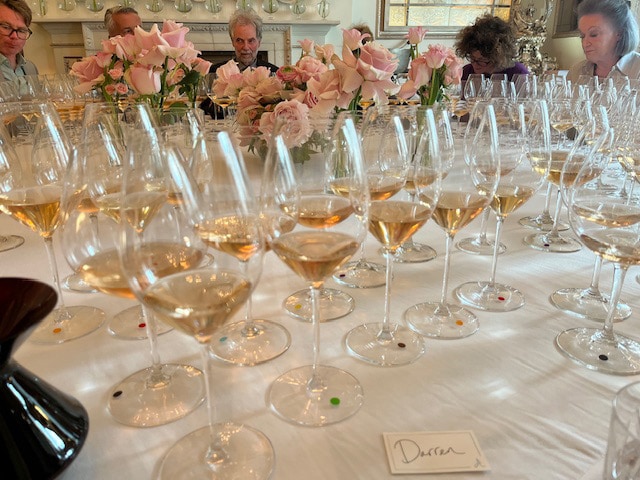
A Haven of Tranquil Elegance
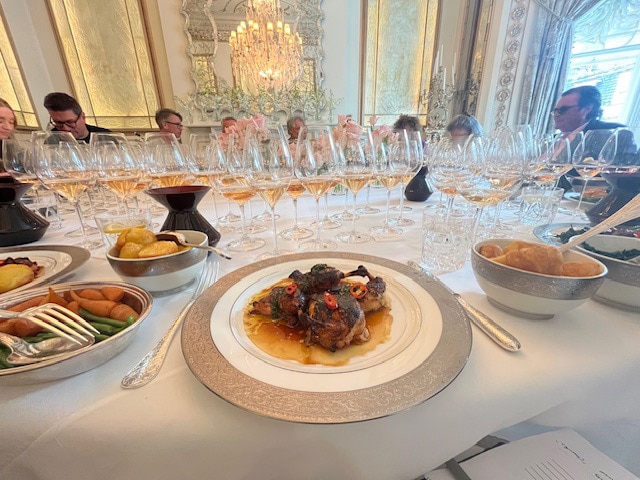
Located in the heart of London’s Mayfair, Annabel’s is renowned as one of the world’s most prestigious private members’ clubs. Established in 1963, it has long been a symbol of sophistication and exclusivity. In 2018, Annabel’s underwent a stunning transformation, moving to 46 Berkeley Square and receiving a lavish redesign by the acclaimed Martin Brudnizki Design Studio. The redesign beautifully preserved the building’s historic features, including its grand staircase, intricate plaster ceilings, and elegant fireplaces.
Our tasting took place in the haven of tranquil elegance known as The Silver Room. Overlooking the enchanting garden this room is adorned with original Georgian features, meticulously restored with silver detailing. The bespoke silver glass panels depict classical figures, creating a sophisticated and serene atmosphere. Designed for private events, the Silver Room made it perfect setting for this intimate lunch.
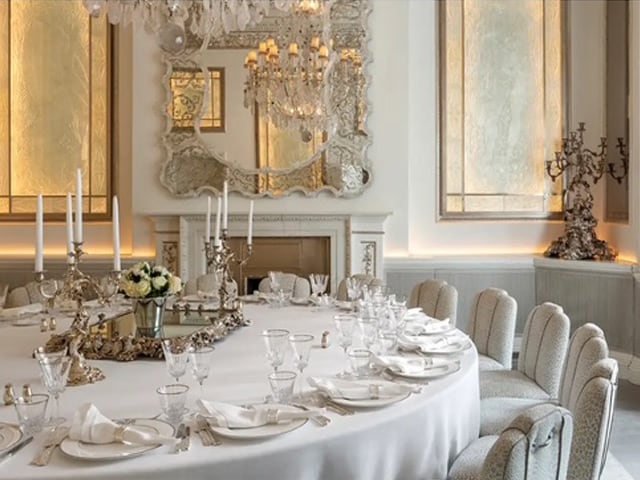
The visionary
Sacha Lichine, a visionary in the wine industry, has against all the odds, transformed Château d’Esclans into a symbol of excellence in Provence. Born in Bordeaux and educated in America, Sacha has immersed himself in every facet of the wine business, from production to sales. His early experiences at his family’s former estates, Château Prieuré Lichine and Château Lascombes, provided him with a solid foundation in winemaking and the wine trade.
In 2006, Sacha left Bordeaux and acquired Château d’Esclans, located in the picturesque hills northeast of St. Tropez. With a bold vision to create the world’s finest rosés, he spearheaded what is now known as the ‘Rosé Renaissance’. It was a huge risk, Sacha smiled as he shared, he’d just read the book ‘No Risk, No Fun’. Back then some people did think he was crazy, trading his family business in Bordeaux to make Rose in Provence, “Bankers wouldn’t give me an overdraft, and the trade would say ‘rosé doesn’t sell’. Sacha explained that when building a brand you need to have three or four layers, price points and therefore the fine wines are accompanied by the world famous Whispering Angel, now selling over £10m bottles worldwide (up from 130,000) along with Rock Angel, “a kind of Super Whispering”, and Chateau D’Esclans. We were keen to know where he got the ideas for their names, “Whispering Angel, Rock Angel are names inspired by the chapel at the property, with cherubs above the altar and Garrus is the knoll, or plot in the hillside at the estate”.
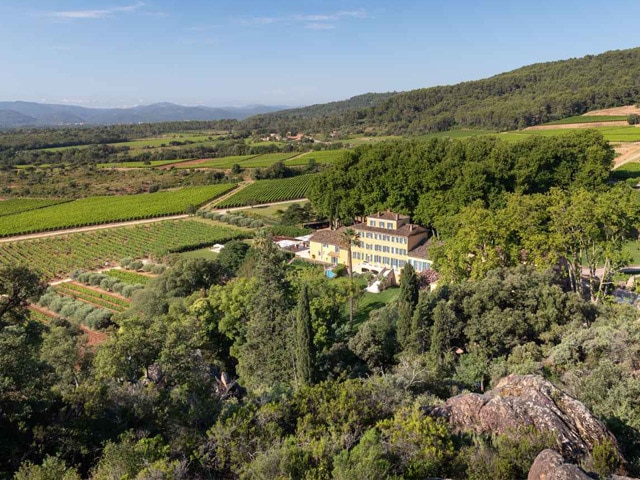
Les Clans and Garrus: The Pinnacle of Fine Wines
Many people think of rosé as a simple, summer drink, best enjoyed in the sunshine and often consumed without much thought. However, it might be surprising to learn that rosé can have the complexity and longevity of fine wines. Les Clans and Garrus, in particular, defy these expectations with their remarkable depth and aging potential. We tasted through Les Clans and Garrus 2023, 2022, 2021, 2020 and 2017. Both are exceptional examples of fine wines that challenge the conventional perceptions of rosé. All the grapes used are estate grown grapes, with Les Clans vines being 50-70 years old and Garrus being older. The wines resemble a white at the beginning and finish as a red, a style they have been perfecting with the 2023 vintage.
The colour can be deceiving to some, its light and pale, and you’d be forgiven for thinking it wouldn’t have much taste and body but it’s just to the contrary. Whilst there is very little colour variation across these vintages Sacha’s focus is on “consistency of style rather than colour, seeking elegance in the ripe and well-grown Grenache”. The blend of Grenache and Rolle produces refined flavours, with Rolle adding richness. “A tad of Tibouren contributes a floral touch”, though Sacha is not a great fan of it. He emphasised that” the wine must deserve the wood it ages in”. Experimentation with different barrels, woods, and coopers has led to wines that never taste of wood but offer an extra layer of complexity, making them linger on the palate.
The 2023 vintage stands out as a remarkable year for both Les Clans and Garrus. This vintage represents a significant milestone in the history of Provence rosé, with all three Château d’Esclans wines achieving exceptional acclaim. Garrus is characterised by its remarkable clarity and brightness, showcasing a refined structure and subtle notes of oak and almond. The wine’s elegance and composure are reminiscent of some of the finest Burgundian whites. But “its tyring to be its own individual style, it might resemble white burgundy but has a style of its own, it tastes well”. Les Clans from 2023 is celebrated for its harmonious balance and versatility, making it an excellent choice for pairing with a wide range of dishes.
Whilst I thoroughly enjoyed all of them the 2020 vintage stood out as my favourite. They have proven to be exceptional, demonstrating the potential for aging and the depth of flavour that can be achieved with meticulous winemaking. These wines are not only a delight to drink now but also promise to continue evolving beautifully in the years to come.
Their ability to age gracefully is a testament to the meticulous craftsmanship and innovative techniques employed in their production. These wines evolve beautifully over time, developing deeper flavours and greater complexity, making them ideal for aging. “We’re not trying to change the world, what we’re trying to offer is that rose can be a fine wine if one wants it to be”.
A race against oxidation
Sacha’s dedication to quality is evident in every aspect of the production process. From handpicking the grapes to experimenting with different barrels and woods, every detail is carefully considered. Harvesting is completed by lunchtime, using crates with dry ice and pellets to maintain the coolness of the grapes, preserving the fruit and flavour until the last moment. With the help of a group of engineers from Bordeaux, his team has developed a state-of-the-art technology, including nitrogen gas to reduce oxidation and a glycol system with tentacles that chill inside the barrels. This innovation allows for controlled fermentation at different temperatures, making these wines possible today. “You wouldn’t be able to make rosé like this if it wasn’t for the technology.” Garrus, comprising 90% free-run juice the wine is vinified in the whitest 600-litre barrels you will come across, new oak (20%), second-year oak (40%), and third-year oak (40%). Renewing the barrels every three years undergoing bâtonnage twice weekly over an eleven-month period gives the wines a lovely blanched almond flavour, whilst building structure and depth.
The risk paid off
The 2025 vintage, set to be released in 2026, will mark the Chateau’s 20th vintage. The investment in Provence has grown reflecting the commitment to quality. The category is improving, and as it does, interest grows.
The risk taken has paid off, with the wines now available in 110 countries. 50% of sales are in the US and 25% in the UK, with the rest of the world accounting for the final 25%. Sacha hails the UK as being crucial for the fine wine market, and without it, there would be no such market.
Conclusion
Sacha Lichine’s dedication to innovation and quality has brought Provence rosé to the global map. His wines, from Whispering Angel to Garrus, showcase the potential of rosé as a fine wine, driven by a vision of elegance and refinement.
Les Clans and Garrus are more than just rosé wines; they are masterpieces that showcase the potential of rosé as fine wine. Their age-worthiness and compatibility with food, combined with Sacha Lichine’s expertise and commitment to quality, make them truly exceptional. These wines are a testament to the fact that with the right knowledge and investment, rosé can achieve the same level of sophistication and elegance as the finest wines in the world.
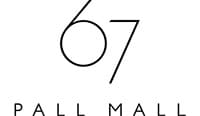
67 PALL MALL MEMBERS NEWSLETTER
13th March 2025
By Guy Woodward
What I’ve learned | Sacha Lichine, chateau d’Esclans
Son of the legendary wine writer, chateau owner and businessman Alexis Lichine, Sacha Lichine inherited Bordeaux classed growth Chateau Prieuré-Lichine in 1989 at the age of 78, before selling the property a decade later and investing in Chateau; ‘Grape prices in Provence have quadrupled [due to the demand spurred by the success of the category], which is great, dEsclans in Provence. His success there has played a major part in the growth of Provence rosé, and in 2079 he sold a majority share in the property to LVMH
‘There’s a place for serious Provence rosé, and we’re aiming for it. When we started out with Chateau d’Esclans, there was no rosé market at all. We developed it, and now we’re trying to improve and grow it. We just want to make fine wine.’
‘There’s still a massive snobbism to overcome around Provence rosé. Every day | fight with people who turn their nose up at it. | was talking to a sommelier in another London club the other day, who did the same — and he was Australian People forget that wine is not about labels, it’s about pleasure. My father used to say, “We’re merchants of pleasure.”
‘We started by making 130,000 bottles [a year]. Now it’s 15 million. Whispering Angel is around 10 million of that, and is made from 99% purchased fruit. We followed a Champagne approach — Whispering Angel is the NV, and then you move up the chain with the other cuvées [Rock Angel, Les Clans and Garrus].’
‘Grape prices in Provence have quadrupled [due to the demand spurred by the success of the category], which is great, because it means growers can invest in their vineyards — and you have to invest in order to achieve quality.’ ‘Why can’t rosé be a year-round drink? 50-60 years ago, white wine was only ever drunk in summer. Today, | think top-end rosé can be on the same table as classed growth Bordeaux. Garrus as an aperitif, Cos d’Estournel with the main’
‘All we’re trying to say is, “Here’s something for the fine wine lover who is used to drinking Burgundy and Rhéne and fine things out of Australia and California and so forth. Here’s a category which is a little lighter in style, a little more precise, and has just 0.7 grams of sugar per litre. It’s not just an aperitif. You can drink it before dinner, during dinner and after dinner.” That was the idea, and | think there’s a spot to be taken becoming the Chateau Margaux of rosé. Then the perception of rose will change — and our job will be done.’
‘People say a lot of Provence rosé is average. But there’s average wine everywhere — average Burgundy, average Bordeaux. Trust me, there’s a lot of average Bordeaux.’
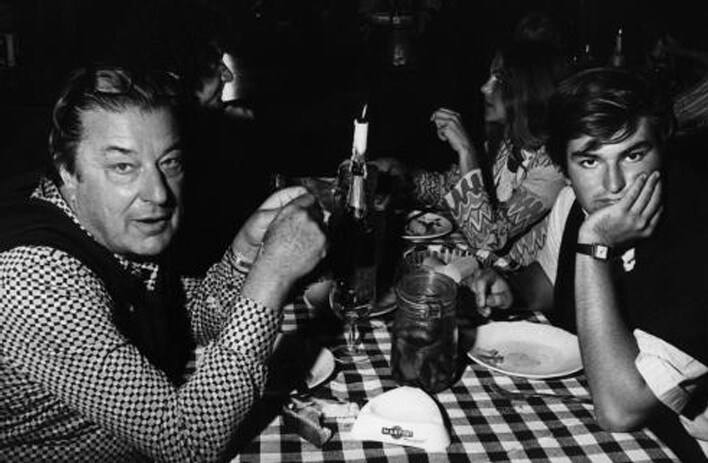
‘If you want to build a brand, you have to start in the US. Everything follows from there. But the UK is still the greatest fine wine market in the world. The UK practically invented the fine wine market. The French only started discovering their own fine wines in the 1980s.’
‘Patrick Léon [the Bordeaux consultant, and former winemaker of Mouton-Rothschild who Lichine engaged to make the first d’Esclans wines] wanted to make a Tavel-style rosé. I had fights with him about it. He didn’t believe in the project, he didn’t believe we could take rosé where we took it. His taste was for juicier, richer, Syrah-based wines. But he was the greatest technician I ever met — if you gave him a brief for the profile of wine you wanted, he could make it. So I said to him, “Look, I follow women’s trends – I like women — and women are going towards Sauvignon Blanc.” This was the late 90s, when Americans thought Sancerre was a grape variety. At night, when I’d been working all day, I’d get home and I just wanted a glass of New Zealand Sauvignon Blanc. I was amazed how Cloudy Bay had emerged and been able to make a brand out of a place called Marlborough. So I said to him, “If they can do that, think what we can do with something pink, something French, something sexy, something from Provence, from St Tropez.”
‘I never thought it would be as successful as it has been. And I was all in. I had 50% of the sale of Preiuré-Lichine — I had to the banks back, the inheritance tax, and I’d tried some start-ups in Languedoc that were losing money. Then I landed this stupendous property.’
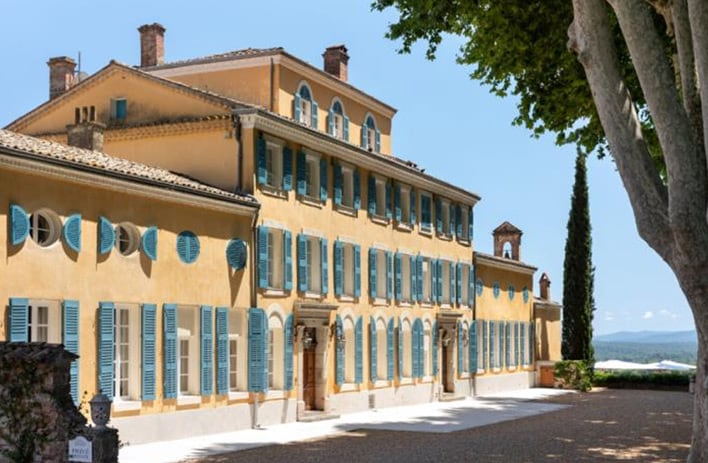
‘Women have been the key to the success of Provence rosé. They’ve driven the category. It hit that female Sauvignon Blanc consumer just at the right time. Men think they have to drink chest-beating wines, 15% Malbec that makes you think you have a Shetland sweater in your mouth. | grew up drinking Bordeaux that was fresh, elegant and 12.5% alcohol.’
‘I drank quite a bit of Pinot too. My father introduced estate bottling into Burgundy through his Alexis Lichine Selection. He bought the entire crop of Clos de Lambrays’ 1949 vintage. I grew up in my father’s cellar, and the only wine he would never notice was missing was ‘49 Clos de Lambrays. He couldn’t sell it at the time, so there was so much of it around and I would help myself to a few bottles. I told this story to Bernard Arnault [CEQ of LVMH, which now owns Clos des Lambrays, and to which Lichine sold 55% of the business in 2019] when he came to see me at Chateau d’Esclans. The next day, I received a bottle of ‘49 Clos de Lambrays, with a handwritten note from him, and it was absolutely magnificent. I must say he did sort of seduce me.’
‘Bordeaux is a very small town. It’s very incestuous. The sport is trying to sleep with everybody’s else’s wife. You don’t talk to people directly. You have to talk through brokers.’
‘I didn’t want to follow in my father’s footsteps. But ultimately, | think my father would have been very proud of what we’ve achieved with d’Esclans. He would have probably taken half of the money, but he would have been very proud’
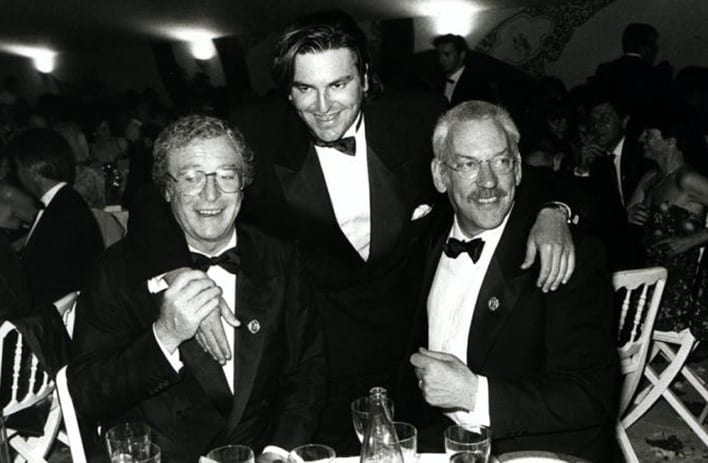
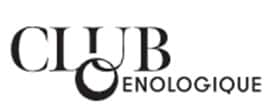
Tasting the best of Château d’Esclans: five vintages of Garrus and Les Clans
April 9, 2025
By David Kermode
Château d’Esclans’ Sacha Lichine set the wine world alright with Whespering Angel but he’s still out to prove that rosé can be a serious, age-worthy style. David Kermode explores the story behind arguably the world’s most famous rosé producer and gives his verdict on vertical tastings of the estate’s top two wines, Garrus and Les Clans.
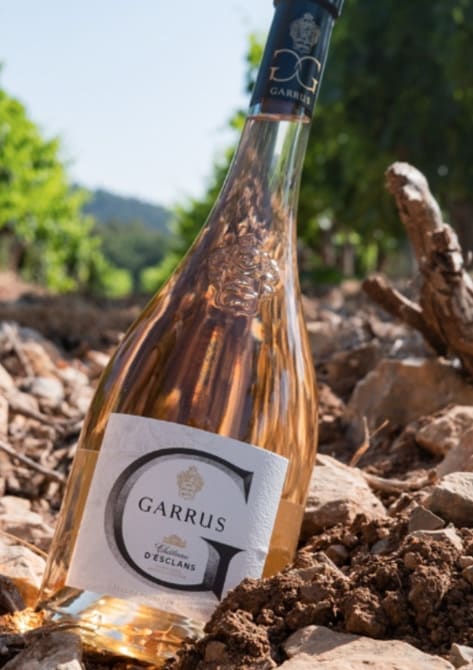

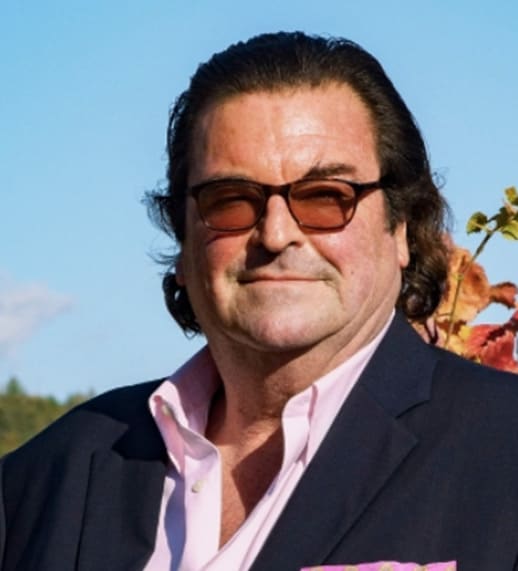

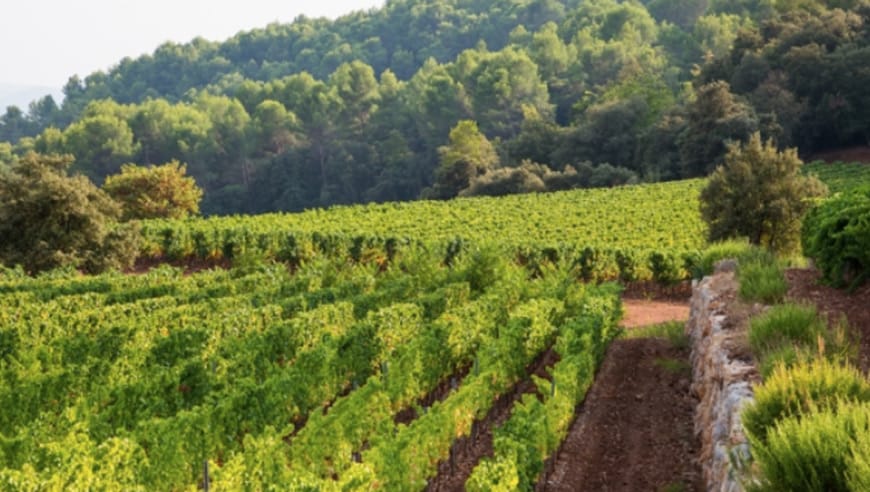
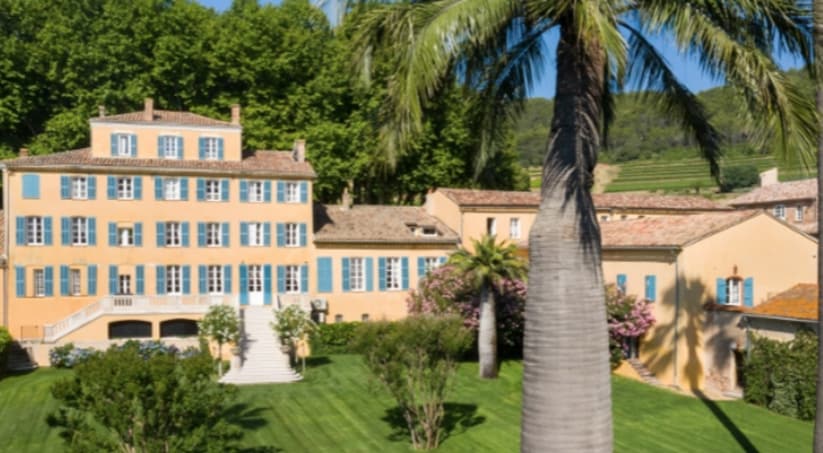

Two mini vertical showcasing the ageability of Château d’Esclans premium rosé
